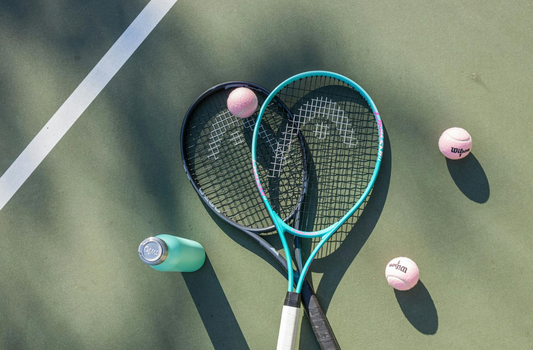Have you had enough of rallying with your friend or serving ball after ball out of a hopper? Maybe you’re looking forward to some friendly competition. If you’re getting ready to play your first tennis match, we’re here to make sure you have a firm grasp of the basic procedures before you head out to the courts. From the scoring system to the way a match progresses, we’ve got you covered.
The Court
First, familiarize yourself with the layout of the court.
Scoring
Tennis players play a match, which consists of sets, made of games that consist of points. To win a tennis match, a player needs to win two sets. To win a set, a player needs to win at least six games. To win each game, a player needs to win at least four points.

If both players win three points, the score is 40-40, or “deuce.” At deuce, a player must win two points in a row to win the game.
For a more detailed description of tennis scoring, check out this article.

Source: ©Drobot Dean - stock.adobe.com
Warm-up
To decide who starts serving, one player generally flips a coin or spins a racket. The winner can choose to start serving, receiving, or the end of the court to start playing on. To get some in-depth insights into the coin toss, check out this article.
After the sides have been determined, you should warm up. The warm-up should be five to ten minutes, and it is not a chance to practice. Hit shots directly to the opponent at a medium pace, and try to loosen up your muscles and get a feel for the ball. Don’t forget to warm up your serve at this time as well.

Source: stock.adobe.com
Serving
Before the start of every point, the player serving should call the score out loud so the person receiving can hear it. The score is stated as the server’s score and then the receiver’s score.
The first server starts serving behind the baseline on the deuce side, and the opponent returns from the deuce side. The serve must be hit crosscourt into the service box to start the point.
The server has two chances to hit the serve inside the service box. If the server does not hit the first serve into the correct service box, it’s called a “fault,” and the server gets another chance. If both attempts don’t go into the correct service box, it’s a “double fault,” and the receiver wins the point.
When the serve hits the net before bouncing in the correct service box, it’s called a “let.” If “let” happens during the first serve, the player will have two more chances to put the serve in. If it is during the second serve, the player has one more chance to put the serve in.
For more details about serving, check out this article.
Point Play
The player returning must hit the serve back after the bounce. The point will go on until somebody hits the net, hits the ball out, double bounces, hits the body of a player, if the racket or the player touches the net, or if a player hits the ball more than once in a row.

Source: © houses.photos - stock.adobe.com
Changing Ends
Changing ends of the court happens in every odd-numbered game, for example, after playing the 1st game, 3rd game, 5th game, and so on. Players do not take a break during the first changeover, but there is a 90-second changeover after every subsequent odd-numbered game. For more details about time rules, check out this article.
Tie-break
To win a set, a player must win six games by a two game advantage. If a set gets to 6-6, a tie-break is played to decide who takes the set. A tie-break is played to seven points. A margin of at least two points needs to be met as well (e.g.,7-5 or 8-6). An in-depth description of tie-break procedures can be found here.
Alternative no Ad-Scoring system
Point by point is the same as the traditional scoring system. The only difference is when both players reach 40-40 or deuce in the game. The player winning the next point wins, and the player returning the serve chooses on which side to return.
Source: ©vachiraphan - stock.adobe.com
Calling Lines
Umpires and line judges only call matches in high-level tournaments. Most recreational tennis players make their own calls, and it is important to show good sportsmanship by being honest at all times. If the ball touches any part of the line, the ball is good. If you’re not sure whether the ball was in or out, the ball is good. You can only call balls that bounce on your side of the court. “Out” calls should be made immediately. If you’re unsure if the ball was out, you should continue to play the point. Even if you think the ball is going to bounce out of the court, you should always let it bounce because if you catch it on the fly, you lose the point.
If you’d like a detailed breakdown of which player should make the call in questionable scenarios, check out this article.

Source: © Copyright 2006, Mike Watson Images Limited – stock.adobe.com
Doubles
In a doubles match, you and your partner play the other two players on the other side of the net. Remember that doubles alleys are part of the equation, so if the ball bounces in the doubles alleys, the ball is in.
Whoever starts serving serves for the whole game. Usually, the player with the stronger serve will serve first. After finishing each service game, it is the turn of serve for the other team.
Tip: Make sure to discuss with your partner which side of the court suits your style of play better. For example, if you are a righty, and your forehand is your best shot, it would be best for you to play on the deuce side (right side) of the court. It is also important to point out that you can’t change sides with your partner in the middle of the set. It is not until the set finishes that you can switch sides for returning serves if desired.
Conclusion
Now that you know the basics of how a tennis match runs, go out there, apply, and have fun! The rules may sound a bit complicated on paper, but once you play a couple of times, you’ll get the hang of it quickly! If you need some help figuring out what kind of equipment you need and where you can find a court, check out this article,






